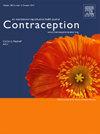血浆和血清中依托诺雌醇生物分析测定结果在实验室内和实验室间的比较。
IF 2.3
2区 医学
Q1 OBSTETRICS & GYNECOLOGY
引用次数: 0
摘要
研究目的研究设计:我们进行了一项盲法研究,共有六家实验室参加:五家学术实验室和一家签约商业实验室(参考实验室)。每个实验室都对制备的六种已知依托孕烯浓度的血清和/或血浆样本以及使用含依托孕烯避孕方法的参试者的 60 份临床样本进行了依托孕烯定量分析。根据监管指南,实验室准确度(偏差百分比)和精密度(变异系数;CV)定义为标称制备浓度的±15%。我们使用 Kendall's Tau-B 和 Passing-Bablok 回归法比较了实验室之间和实验室内部的一致性:结果:对于制备好的样本,6 个实验室分析了血清,3 个实验室分析了血浆。包括参比实验室在内的四家实验室所有依托孕烯浓度的准确度均在±15%以内。所有实验室的精确度都很高,只有一家实验室的 CV 值大于 15%。我们发现制备的血浆和血清中的依托孕烯结果之间存在正相关(Kendall's Tau-B 0.80-0.88)。对于临床样本,5 家实验室分析血清,3 家实验室分析血浆。与参比实验室相比,实验室间的血清依托孕烯浓度呈正相关(Kendall's Tau-B 0.76-0.95)。观察到了比例偏差,即单个实验室的依托孕烯结果始终高于(斜率估计值 0.78-0.95)或低于(斜率估计值 1.05-1.10)参照实验室。在临床样本中,血浆和血清之间的实验室内结果关联良好(Kendall's Tau-B 0.92-0.96):结论:无论样品基质如何,实验室内的一致性都很好;然而,依托孕烯结果在实验室间存在差异。在比较不同研究的依托孕烯药代动力学时,应考虑实验室结果之间的差异。本文章由计算机程序翻译,如有差异,请以英文原文为准。
Comparison of etonogestrel bioanalytical assay results in plasma and serum within and across laboratories
Objectives
To compare performance characteristics of etonogestrel bioanalytical assays across laboratories.
Study design
We conducted a blinded, six laboratory study: five academic laboratories and one contracted commercial laboratory (reference). Etonogestrel was quantitated at each laboratory in both prepared serum and/or plasma samples of six known etonogestrel concentrations, and in 60 clinical samples from participants using etonogestrel-containing contraceptive methods. Per regulatory guidance, laboratory accuracy (percent bias) and precision (coefficient of variation; CV) were defined as ±15% of the nominal prepared concentration. We compared inter- and intra-laboratory agreement using a Kendall’s Tau-B and Passing-Bablok regression.
Results
For prepared samples, six laboratories analyzed serum and three laboratories analyzed plasma. All etonogestrel results were within ±15% for accuracy across all concentrations at four labs, including the reference laboratory. All labs demonstrated high precision, with only one occurrence of CV >15%. We found a positive association between prepared plasma and serum etonogestrel results (Kendall’s Tau-B 0.80–0.88). For clinical samples, five laboratories analyzed serum and three laboratories analyzed plasma. Compared to the reference laboratory, inter-laboratory serum etonogestrel concentrations were positively correlated (Kendall’s Tau-B 0.76–0.95). Proportional bias was observed, meaning individual lab etonogestrel results were consistently higher (slope estimates 0.78–0.95) or lower (slope estimates 1.05–1.10) than the reference laboratory. In clinical samples, intra-laboratory results were well associated between plasma and serum (Kendall’s Tau-B 0.92–0.96).
Conclusions
There was good intra-laboratory agreement, irrespective of sample matrix; however, there was inter-laboratory variability in etonogestrel results. Differences between laboratory results should be considered when comparing etonogestrel pharmacokinetics across studies.
Implications
Etonogestrel concentrations were highly precise within each laboratory and were comparable between serum and plasma. Results varied between laboratories (5–28% higher to 5–9% lower compared to the Organon commercial laboratory). To minimize variability, we recommend utilizing a single laboratory that conducts routine proficiency testing for etonogestrel analysis within a study.
求助全文
通过发布文献求助,成功后即可免费获取论文全文。
去求助
来源期刊

Contraception
医学-妇产科学
CiteScore
4.70
自引率
17.20%
发文量
211
审稿时长
69 days
期刊介绍:
Contraception has an open access mirror journal Contraception: X, sharing the same aims and scope, editorial team, submission system and rigorous peer review.
The journal Contraception wishes to advance reproductive health through the rapid publication of the best and most interesting new scholarship regarding contraception and related fields such as abortion. The journal welcomes manuscripts from investigators working in the laboratory, clinical and social sciences, as well as public health and health professions education.
 求助内容:
求助内容: 应助结果提醒方式:
应助结果提醒方式:


